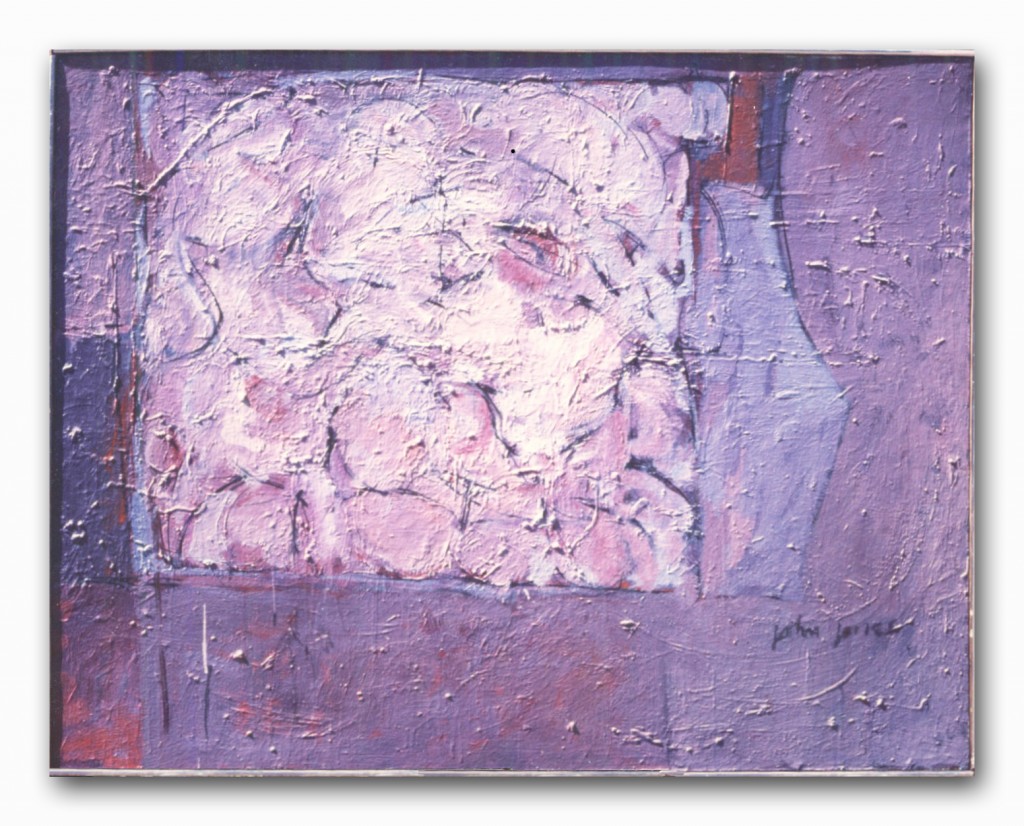by John Jones
Associations Unleashed
Amy Tan says, “Creativity is the lack of suppressed associations.” Took me a minute to get it. What she’s saying is, I believe, equal to saying that creativity is the ability to bring seemingly opposite, or discordant, elements together into a harmonious whole.
Paintings, both realistic and abstract, are the result of the relationships of line, color, form, and texture. The protagonist in my novel, Yellow Mesquite, begins to arrive at a style when he attempts to translate real-life situations into abstractions: shapes, forms, and colors that feel like the subject, as opposed to merely looking like it. For instance, the association of gentle, sinuous shapes interlocking with softly hued flesh tones bathed in moonlight is meant to suggest a languorous mood in The Sensual Bed, the painting on the back cover of YM. Elsewhere, and unrelated to the novel, a painting titled Divorce consists of sharp, angular shapes and violently clashing colors.
To draw a parallel between painting and writing, the words describing the paintings are equal to the visuals themselves in evoking seminal responses. That is, the words gentle, sinuous, languid, and softly elicit a totally different response from the words, sharp, angular, violent and clashing. This is no big news, but something we too often forget when developing a scene. Words have power. They have energy. More powerful than the sword, someone has said. (Personally, I’d rather face off against a dictionary!)
 In the argument of whether it’s better to write with an outline or without, a case could be made for writing without on the assumption that feeling your way along would leave your mind free to stumble upon more unexpected Amy Tan associations than writing with an outline. To me, outlines are just that: outlines. If I’m driving from here to California, I won’t just get in the car and take off heading west. I’ll use a map. But that doesn’t mean I won’t investigate a bit along the way.
In the argument of whether it’s better to write with an outline or without, a case could be made for writing without on the assumption that feeling your way along would leave your mind free to stumble upon more unexpected Amy Tan associations than writing with an outline. To me, outlines are just that: outlines. If I’m driving from here to California, I won’t just get in the car and take off heading west. I’ll use a map. But that doesn’t mean I won’t investigate a bit along the way.
Beginning, Middle, End
I had a hard time finding a satisfactory end to Yellow Mesquite. Writers talk about the “great sagging middle” as being the most problematic. Maybe, but I find beginnings and endings to be the most critical. The beginning is a promise: Here is this situation, here is the tone, and here are these characters inviting you to take a trip with them. The end should be a satisfactory parting. “Satisfactory” doesn’t necessarily mean joyful, depending on your genre: Shakespeare’s tragedies don’t exactly leave one euphoric. But the beginnings and the middles foreshadow these dark endings. We sense this isn’t going to end well.
I originally wrote The Dogs of Mexico as a cautionary tale, a tragedy in the classic sense. Robert, basically a decent guy, makes bad decisions and pays with his life. I wrote the ending in alternating viewpoints between Robert and a deranged Mayan Indian. It was really off-the-wall surreal-weird. I liked it.
However, while European audiences are comfortable with dark, somber endings, American audiences like happy, upbeat endings. A good many European movies have had their endings changed for the American audience. So, while I liked my ending, many readers didn’t. I’m almost ashamed to admit that I changed it. However, I like the new ending as well, if not better (otherwise, I wouldn’t have altered it). In both art and literature, you have to live with it for a while—paint and repaint, write and rewrite—until you believe it. Only then is it really right, hopefully.
Yellow Mesquite is a quest: A young man wants to be an artist, and struggles to overcome all kinds of obstacles in the process. That’s the trip. At the end, he’s despondent, mentally and physically exhausted, nose broken, eyes blackened. After being severely rebuked by the one woman he might have found happiness with, he’s leaving the subway on Canal Street in New York when someone yells from behind. He turns to see a drunken derelict shouting at him, “Who are you?” He ignores the man, but sometime later he arrives at his loft where he’s comforted by his paintings, the smell of oil paint, turpentine, linseed oil. It occurs to him that this is what is important:
Even as his stomach clenched over Frankie, miserable over the breakup, guilt ridden for how he had treated her, he wondered briefly—and against his will—how he might turn such a conundrum into a work on canvas.
If, as some pundits claimed, art was dead, that had little to do with him.
Art. That’s what he did. That’s who he was.
My hope is that the reader will associate the protagonist’s declaration, “Art. That’s what he did. That’s who he was,” with the derelict’s earlier question, “Who are you.” Simplistic, but that’s what the entire novel is about. I confess that I stole this idea (in a different form) from Lawrence of Arabia. Picasso said, “I never borrow from other artists. I steal from them. I take it and make it my own.”
Good enough for me.
